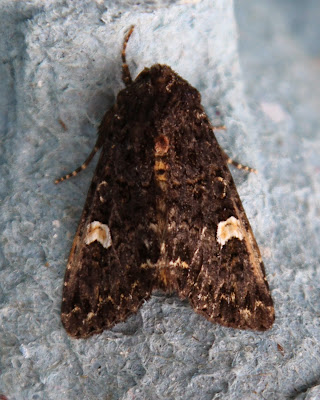Last night it was hot, clear and very muggy, the forecast was for drizzle in the early morning, clearing in the afternoon. I decided it was time once again to put the moth trap out. In the morning when I went out early on to turn the light I could see I had caught quite a few, but I didn’t have my glasses on so I couldn’t see the detail.
When I finally got out to sort them all out, I was very pleased with the results. Mind you it is still very difficult identifying them, but I am beginning to know where to look in the books. So to the moths, and apologies up front for the “un-natural” background in most of these pictures, but I am looking to photograph them as soon as I can to ensure they don’t fly away.
First off was a Pebble Hooktip
The next was this rather neutral Plain Wave
I have seen this moth before in the garden; it is a Brimstone Moth, it being very similar in colour to the Brimstone butterfly
This next one gave me some difficulty in finding it. Eventually I had to go to google, and I found it, an Orange Mint Moth, although it is normally known by the Latin name Pyrausta ostrinalis.
Then there were the beauties. This is an Elephant Hawk Moth, apparently quite common in gardens, but I have never seen it here before
This was then followed by the equally impressive Poplar Hawk Moth. When at rest, as it is in the ivy, it holds its wings like they are dead leaves
Back to the smaller moths now, a Scalloped Oak
A Flame Shoulder
And a Dot Moth
This is called The Herald, and looks extremely splendid close up
This little beauty is a Small Phoenix, look at the detail in the wings
I thought I was finished, but as I began to dismantle the trap, I found a few more different species. This is a Ruby Tiger, and you can’t quite see it here, but when the wings open further the hind wing is a lovely reddish pink
The next two were an identification challenge, the first one is I think, a Sycamore
And this one is I think a Tissue
Looking just like a bit of peat or twig, this is a Garden Dart
This tiny moth caught my eye as I was clearing the tiny white ones off the egg boxes, it is known only as Catoptria pinella
Again you would think this one was easy, and from its name it should have been, but it wasn’t. It is a Common Rustic
Finally the trap was empty, and this one tried to evade the camera by flying off, but I managed to find it on the garden fence. It is a small Magpie, it lacks the distinctive yellow that you finfd in the Magpie moth
Some really lovely species here today, and looking into the hawk moths it seems the best time for them is late August through to October, so who knows what others are yet to turn up.
It is amazing to think that there are so many different animals in the garden, and normally you just wouldn’t see them





















If anyone ever says moths are brown and boring,I always say to look a little closer and now to look at these pictures and buy a moth trap..simply wonderful!
ReplyDeleteBuy that moth trap! It's like Christmas every day, when you get up wondering what you will find under the tree!
ReplyDelete